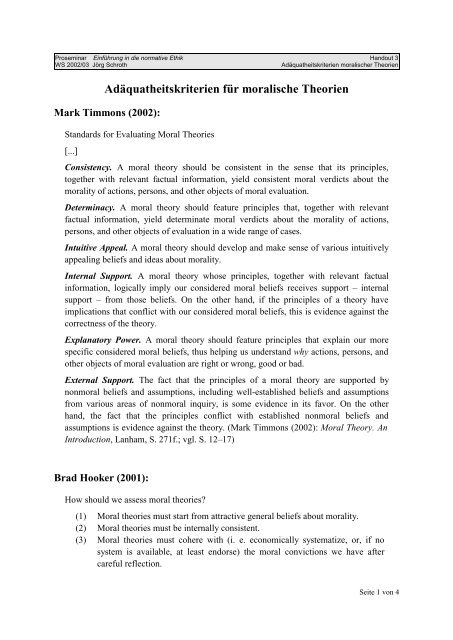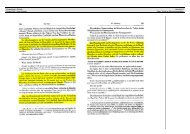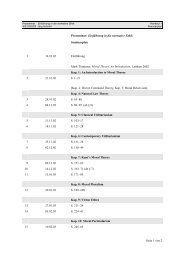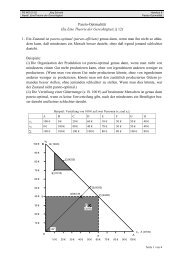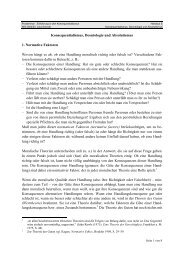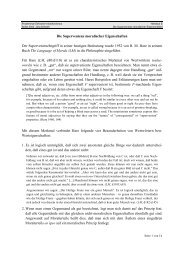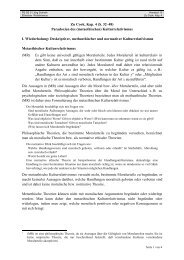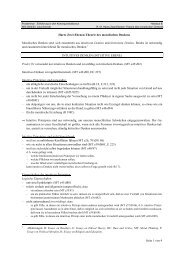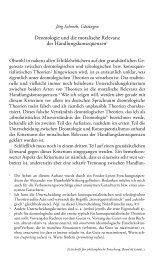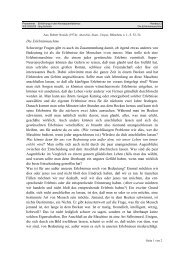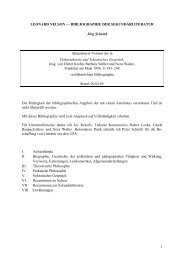Adäquatheitskriterien für moralische Theorien - Jörg Schroth
Adäquatheitskriterien für moralische Theorien - Jörg Schroth
Adäquatheitskriterien für moralische Theorien - Jörg Schroth
You also want an ePaper? Increase the reach of your titles
YUMPU automatically turns print PDFs into web optimized ePapers that Google loves.
Proseminar Einführung in die normative Ethik Handout 3<br />
WS 2002/03 <strong>Jörg</strong> <strong>Schroth</strong> <strong>Adäquatheitskriterien</strong> <strong>moralische</strong>r <strong>Theorien</strong><br />
<strong>Adäquatheitskriterien</strong> <strong>für</strong> <strong>moralische</strong> <strong>Theorien</strong><br />
Mark Timmons (2002):<br />
Standards for Evaluating Moral Theories<br />
[...]<br />
Consistency. A moral theory should be consistent in the sense that its principles,<br />
together with relevant factual information, yield consistent moral verdicts about the<br />
morality of actions, persons, and other objects of moral evaluation.<br />
Determinacy. Amoral theory should feature principles that, together with relevant<br />
factual information, yield determinate moral verdicts about the morality of actions,<br />
persons, and other objects of evaluation in a wide range of cases.<br />
Intuitive Appeal. Amoral theory should develop and make sense of various intuitively<br />
appealing beliefs and ideas about morality.<br />
Internal Support. A moral theory whose principles, together with relevant factual<br />
information, logically imply our considered moral beliefs receives support –internal<br />
support –from those beliefs. On the other hand, if the principles of atheory have<br />
implications that conflict with our considered moral beliefs, this is evidence against the<br />
correctness of the theory.<br />
Explanatory Power. Amoral theory should feature principles that explain our more<br />
specific considered moral beliefs, thus helping us understand why actions, persons, and<br />
other objects of moral evaluation are right or wrong, good or bad.<br />
External Support. The fact that the principles of amoral theory are supported by<br />
nonmoral beliefs and assumptions, including well-established beliefs and assumptions<br />
from various areas of nonmoral inquiry, is some evidence in its favor. On the other<br />
hand, the fact that the principles conflict with established nonmoral beliefs and<br />
assumptions is evidence against the theory. (Mark Timmons (2002): Moral Theory. An<br />
Introduction, Lanham, S. 271f.; vgl. S. 12–17)<br />
Brad Hooker (2001):<br />
How should we assess moral theories?<br />
(1) Moral theories must start from attractive general beliefs about morality.<br />
(2) Moral theories must be internally consistent.<br />
(3) Moral theories must cohere with (i. e. economically systematize, or, if no<br />
system is available, at least endorse) the moral convictions we have after<br />
careful reflection.<br />
Seite 1 von 4
Proseminar Einführung in die normative Ethik Handout 3<br />
WS 2002/03 <strong>Jörg</strong> <strong>Schroth</strong> <strong>Adäquatheitskriterien</strong> <strong>moralische</strong>r <strong>Theorien</strong><br />
(4) Moral theories should identify afundamental principle that both (a) explains<br />
why our more specific considered moral convictions are correct and (b)<br />
justifies them from an impartial point of view.<br />
(5) Moral theories should help us deal with moral questions about which we are<br />
not confident, or do not agree. (Brad Hooker, Ideal Code, Real World, Oxford<br />
2001, S. 4)<br />
Tom L. Beauchamp/James F. Childress (1994)<br />
Awell-developed ethical theory provides aframework within which agents can reflect<br />
on the acceptability of actions and can evaluate moral judgments and moral character.<br />
[...]<br />
Criteria for Theory Construction<br />
We begin with eight conditions of adequacy for an ethical theory. These proposals for<br />
theory construction set forth exemplary conditions for theories, but not so exemplary<br />
that atheory could not satisfy them. That all available theories only partially satisfy the<br />
demands in these conditions is not of concern here. The objective is to provide abasis<br />
from which to assess the defects and the strengths of theories. Satisfaction of these<br />
conditions protects a theory from criticism as a mere list of disconnected norms<br />
generated from our pretheoretic beliefs. The same general criteria of success in amoral<br />
theory can be used for any type of theory (for example, ascientific theory or apolitical<br />
theory). The eight conditions that follow express these criteria.<br />
1. Clarity. First, atheory should be as clear as possible, as awhole and in its parts.<br />
Although we can expect only as much precision of language as is appropriate, more<br />
obscurity and vagueness exists in the literature of ethical theory and biomedical ethics<br />
than is necessary or justified by the subject matter.<br />
2. Coherence. Second, an ethical theory should be internally coherent. There should be<br />
neither conceptual inconsistencies (for example, “strong medical paternalism is justified<br />
only by consent of the patient”) nor contradictory statements (for example, “to be<br />
virtuous is amoral obligation, but virtuous conduct is not obligatory”). [...] However,<br />
consistency is not asufficient condition of agood theory, only anecessary condition. If<br />
an account has implications that are incoherent with other established parts of the<br />
account, some aspect of the theory needs to be changed in away that does not produce<br />
further incoherence. [...]<br />
3. Completeness and Comprehensiveness. A theory should be as complete and<br />
comprehensive as possible. Atheory would be entirely comprehensive if it included all<br />
moral values. Any theory that includes fewer moral values will be somewhere on a<br />
continuum from partially complete to void of important values. [...]<br />
Seite 2 von 4
Proseminar Einführung in die normative Ethik Handout 3<br />
WS 2002/03 <strong>Jörg</strong> <strong>Schroth</strong> <strong>Adäquatheitskriterien</strong> <strong>moralische</strong>r <strong>Theorien</strong><br />
4. Simplicity. If atheorywith afew basic norms generates sufficient moral content, then<br />
that theoryis preferable to atheorywith more norms but no additional content. Atheory<br />
should have no more norms than are necessary, and no more than people can use<br />
without confusion. However, morality is complicated, and any comprehensive moral<br />
theory will be immensely complex. We can demand only as much simplicity in amoral<br />
theory as its subject matter permits.<br />
5. Explanatory Power. Atheory has explanatory power when it provides enough insight<br />
to help us understand the moral life: its purpose, its objective or subjective status, how<br />
rights are related to obligations, and the like.<br />
6. Justificatory Power. Atheory should also give us grounds for justified belief, not a<br />
reformulation of beliefs we already possess. For example, the distinction between acts<br />
and omissions underlies many critical beliefs in biomedical ethics, such as the belief that<br />
killing is impermissible and allowing to die permissible. But amoral theory would be<br />
impoverished if it only expressed this distinction without determining whether the<br />
distinction justifiably grounds those beliefs. Agood theory also should have the power<br />
to criticize defective beliefs, no matter how widely accepted those beliefs may be.<br />
7. Output Power. Atheory has output power when it produces judgments that were not<br />
in the original data base of particular and general considered judgments on which the<br />
theorywas constructed. If atheorydid no more than repeat the list of judgments thought<br />
to be sound prior to the construction of the theory, nothing would have been<br />
accomplished. For example, if the parts of a theory pertaining to obligations of<br />
beneficence do not yield new judgments about role obligations of care in medicine<br />
beyond those assumed in constructing the theory, this failure of output suggests that the<br />
theory is purely aclassification scheme. Atheory, then, must generate more than alist<br />
of the axioms present in pretheoretic belief.<br />
8. Practicability. Aproposed moral theory is unacceptable if its requirements are so<br />
demanding that they probably cannot be satisfied or could be satisfied by only afew<br />
extraordinary persons or communities. Amoral theory that presents utopian ideals,<br />
paltry expectations, or unfeasible recommendations fails the criterion of practicability.<br />
For example, if atheory proposed such high requirements for personal autonomy[...] or<br />
such lofty standards of social justice [...] that, realistically, no person could be<br />
autonomous and no society could be just, the proposed theory would be deeply<br />
defective.<br />
Other general criteria could be formulated, but the eight sketched above are the most<br />
important for our purposes. Atheory can receive ahigh score on the basis of one<br />
criterion and alow score on the basis of another. For example, early in this chapter<br />
utilitarianism is depicted as an internally coherent, simple, and comprehensive theory<br />
with exceptional output power, yet it is not coherent with some of our vital considered<br />
judgments, especially with certain judgments about justice, human rights, and the<br />
importance of personal projects. By contrast, Kantian theories are consistent with many<br />
of our considered judgments, but their clarity, simplicity, and output power are limited.<br />
Seite 3 von 4
Proseminar Einführung in die normative Ethik Handout 3<br />
WS 2002/03 <strong>Jörg</strong> <strong>Schroth</strong> <strong>Adäquatheitskriterien</strong> <strong>moralische</strong>r <strong>Theorien</strong><br />
Acontested and appropriately criticized moral theory may nonetheless be defensible in<br />
light of the criteria we have proposed. Although we currently have no perfect or even<br />
best moral theory, several good theories are available. (Tom L. Beauchamp/James F.<br />
Childress (1994): Principles of Biomedical Ethics, 4. Aufl., Oxford, S. 44–47)<br />
Shelly Kagan (1989):<br />
In moral philosophy we want to apply the same sort of criteria that we use for theory<br />
building quite generally: we want our moral theory to have simplicity, power, and<br />
coherence.<br />
[...] roughly, amoral theory has simplicity if it yields abody of judgments out of a<br />
relatively sparse amount of theory, deriving the numerous complex variations of the<br />
phenomena from asmaller number of basic principles. [...] Amoral theory has power<br />
when it yields judgments not included in the original data base. [...] Coherence on this<br />
account can be taken as consistency [...]. (ShellyKagan, The Limits of Morality, Oxford<br />
1989, S. 11)<br />
We want the principles to hang together, to be mutually supportive, to be jointly<br />
illuminated by the moral concepts to which we appeal. [...] they must form, or be part<br />
of, a coherent moral theory.<br />
Seeing that the criterion of coherence is richer than that of mere consistencyshould also<br />
lead us to recognize the importance of afourth criterion for moral theories [...]: atheory<br />
must be explanatory. [...] even if the maxims form amutually consistent set, we still<br />
want our theory to provide an account of the distinctions, goals, restrictions, and the<br />
like, which they embody as well. An adequate justification for aset of principles<br />
requires an explanation of those principles –an explanation of why exactly these goals,<br />
restrictions, and so on, should be given weight, and not others. [...] Unless we can offer<br />
acoherent explanation of our principles (orshow that theyneed no further justification),<br />
we cannot consider them justified, and we may have reason to reject them.<br />
This need for explanation in moral theory cannot be overemphasized. We want our<br />
moral theory to help us to understand the moral realm. (Indeed, one of the things we<br />
want our moral theory to help us to understand is how there can even be amoral realm,<br />
and what sort of objective status it has.) Alarge part of the motivation for the criteria of<br />
simplicity and power is the drive to understand: by reducing the complex to the simple,<br />
we can hope to understand the complex; by having apowerful theory we can hope to<br />
move from a base which is understood to an understanding of new areas. Power,<br />
simplicity, and consistency are valuable in themselves, but it is the need to understand<br />
the moral realm which is, Ibelieve, paramount. Ultimately, unless we have acoherent<br />
explanation of our moral principles, we don’t have satisfactory ground for believing<br />
them to be true. (Shelly Kagan, The Limits of Morality, Oxford 1989, S. 12f.)<br />
Seite 4 von 4


